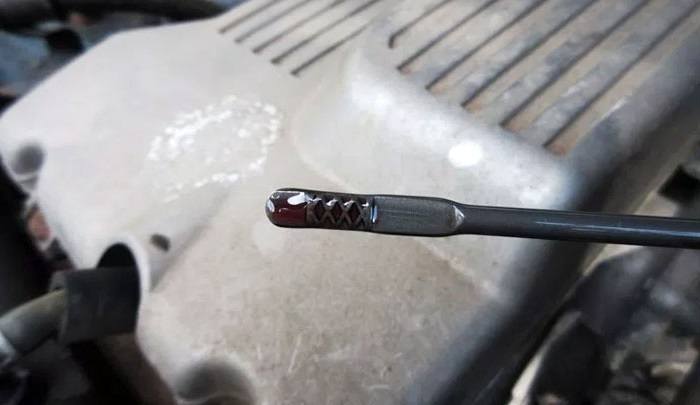by Joshua Thomas
The transmission fluid serves various purposes in your vehicle. Key among them is lubrication to minimize friction to ensure the different transmission components remain in good working condition for a long time.
Transmission fluid is also tasked with cooling the transmission system and transferring power from the engine. In short, the transmission fluid is crucial for the optimal performance of the transmission system and for increasing its lifespan.
Read More: The Best Transmission Cooler
What all this means is that running low on transmission fluid can have adverse consequences. In this piece, we explain the symptoms to watch out for to know when running low on transmission fluid but first here are some of the causes.

Before you can solve the low transmission issue or even know the symptoms to watch out for, it is a good idea to first know some causes to help prevent the problem.
And while there is a myriad of things that can lead to low transmission fluid, the following are some of the main ones.
The transmission line is what moves the fluid around the system to do its job. If it has a hole no matter how tiny it might be, it can eventually lead to low transmission fluid as some of it will be leaking out.
With tiny holes in the transmission line, the leak might not be easily noticeable at first, but over time, it becomes more evident as a significant amount of fluid is lost, and the other symptoms below appear.
A leaking transmission system, just like a hole in the transmission line can lead to low transmission fluid because a lot of the fluid will be wasted.
Leakages will result from factors like overfilling the port with too much fluid and a damaged fluid port or reservoir as a result of accidental impact.
You can easily tell there is a leak in the system by checking underneath the vehicle when you park it. If there is a pool of red fluid, then there is probably a leak in the system.
Read More: Transmission Leak Repair Cost
As you use your vehicle, the transmission fluid just like any other consumable vehicle fluid will also be spent. And although it will not be used up as first as other kinds of fluids, the fact remains that it is used up, and so it is only natural for the level to reduce overtime.
Normal wear and tear of the parts of the transmission system will use up some of the fluid and some of it also evaporates as it is heated up when cooling different components.
It is important to take enough precautions when adding any fluid to your vehicle to not only ensure you use the right type but also avoid other issues such as adding too much or too little.
Adding less transmission fluid when servicing your vehicle is one of the main causes of low transmission fluid contrary to what many motorists tend to assume.
The problem often occurs when you do not check the transmission fluid level correctly before adding more. In some instances, the level that the dipstick will indicate will not be the correct one. Hence, to avoid this issue, you need to know how to check the transmission fluid level carefully.
Read More: How to Add Transmission Fluid

Like with any other vehicle problem, the symptoms of a low fluid level will vary from one vehicle to the other. Hence, no one sign or symptom will tell you for sure that you have a low fluid level.
To ensure a more accurate diagnosis, you need a combination of different symptoms, and here are some of the most common ones to look out for.
Smooth gear shifting relies on clean and adequate transmission fluid to a great extent. Hence, if there is not enough fluid in the system, you can expect to experience difficulties shifting gears.
If there is not enough transmission fluid, the response is often sluggish and tends to lag. For those that drive manual transmission vehicles, sometimes it might take several attempts to shift the gears, and in some cases, you might not even be able to get to certain gears.
With low transmission fluid levels, you can also experience slower or faster gear shifting than usual when driving. This will occur because there will not be enough fluid to maintain the necessary pressure for fast gear change or a smooth transition from one gear to another.
When you notice that every time you shift gears the vehicle falls back out of it, this is a sign that you are experiencing slippage, and in many instances, it will be as a result of low transmission fluid level.
Gear slippage can indicate that the transmission bands and other important components in the transmission system are finding it hard to engage the desired gear fully.
Other issues that often come with a transmission slippage include abnormally high RPMs before gear shifts and groaning noises from the transmission system.
Slippage is often a bad sign as it indicates there is already excessive wear in the transmission system caused by inadequate lubrication.
One of the main functions of transmission fluid is to cool down the transmission system by minimizing friction between different components.
When you are running low on this fluid, you will start noticing the transmission system overheating as excess friction develops between the different metal parts.
If things get worse, you can also start noticing a strong smell from the transmission system as the transmission fluid is burnt by the extra heat produced, and sometimes there will be some smoke.
When you notice this symptom, you will need to inspect the transmission fluid and add more fluid immediately, and in case you cannot add more fluid, you should at least allow the vehicle enough time to cool down before you continue driving.
Given the role that the transmission fluid plays, most of the symptoms when there is an issue such as a low level will mostly be manifested in how the gears engage.
Hence, if you notice that your vehicle has erratic gear shifts, this can also be a sign that you have a low amount of transmission fluid.
Erratic shifts are when the gears are engaged too slow or too fast. This will occur because a low transmission level means the hydraulic pressure will be unstable.
Every transmission system needs stable hydraulic pressure for smooth gear engagement, and if the pressure is unstable, the gear shifts end up being too slow or too hard.
If there is a problem with your vehicle, one of the best ways to diagnose it will be using the check engine light.
If the light comes on, there is an issue with your vehicle, and if you also have one or more of the other symptoms on this list, then the problem might be low transmission fluid level.
Modern vehicles will have a transmission control unit that will detect problems and store their error codes. When the signal for these codes is sent to the ECU, it will turn on the check engine light.
Also, if the computer detects that the problem with the low transmission fluid is severe, it can put the vehicle into limp mode to prevent catastrophic problems.
With a transmission system that is in perfect working condition or where there are no major issues, there should be no noticeable noise coming from the transmission system.
Hence, when you notice any unusual noise coming from your transmission system, this can be an indication that there is a problem and in many instances, the issue can be low transmission fluid level.
The noises will often come from the metal parts grinding hard against each other due to lack of adequate lubrication or gears struggling to shift when you engage them.
Another common sign that you are running out of transmission fluid and one that is often easily overlooked is the presence of a puddle of transmission fluid on your floor.
Whether it is on the driveway or the garage floor, a puddle of red fluid will be a good indication that you are running out of transmission fluid as this is a sign that there is a leak.
In many instances, the puddle of fluid on your floor will result from things like damage to the transmission pan, failed seals and gaskets or a loose drain plug.
And while in some instances these leaks are negligible, it is important to check the fluid level and add more when necessary before you get to fix the issues to ensure your vehicle keeps running smoothly.
Note: The signs of low transmission fluid level can also differ depending on whether the transmission system is a manual or automatic one. For example, a stuck clutch pedal is a common sign of low transmission fluid in manual transmission vehicles, but for automatic ones, it is not since they do not have one.
The transmission fluid is what fuels your transmission system, and without it, you would not be able to anything even changing the gear. And the parts would wear out within a short time due to excessive friction.
It is hence vital to know when you are running low on the transmission fluid and need to add more. But, whether you are a new motorist or an experienced one, this should be quite easy as you only need to watch out for the symptoms above.
Lastly, it is also important to know the other causes of low fluid levels in your vehicle besides natural wear and tear to ensure you prevent them. And also remember to have your vehicle inspected and maintained regularly to keep the transmission system in good working condition.
Sources
 |
 |
 |
 |

About Joshua Thomas
Joshua Thomas just simply loves cars and willing to work on them whenever there's chance... sometimes for free.
He started CarCareTotal back in 2017 from the advices of total strangers who witnessed his amazing skills in car repairs here and there.
His goal with this creation is to help car owners better learn how to maintain and repair their cars; as such, the site would cover alot of areas: troubleshooting, product recommendations, tips & tricks.
Joshua received Bachelor of Science in Mechanical Engineering at San Diego State University.